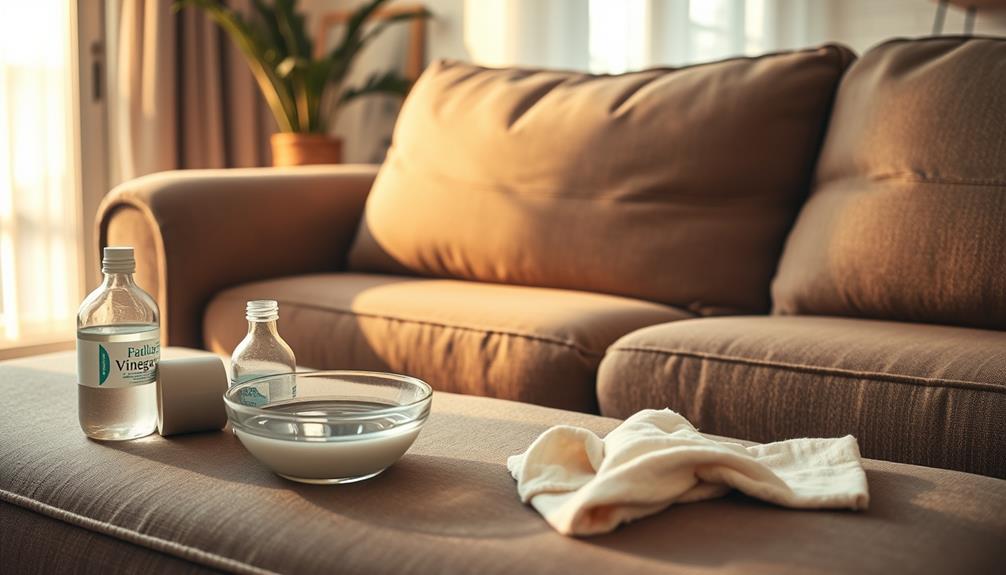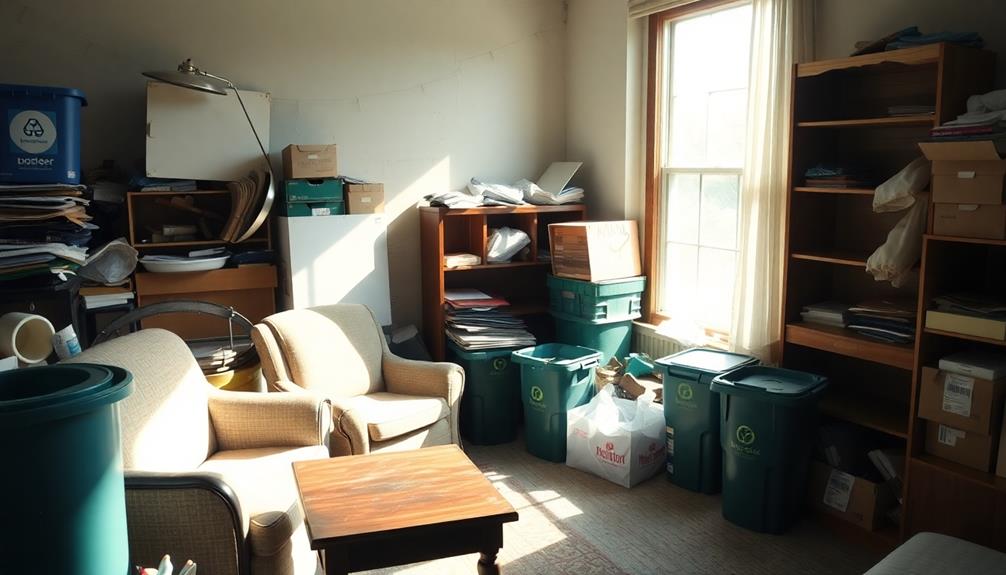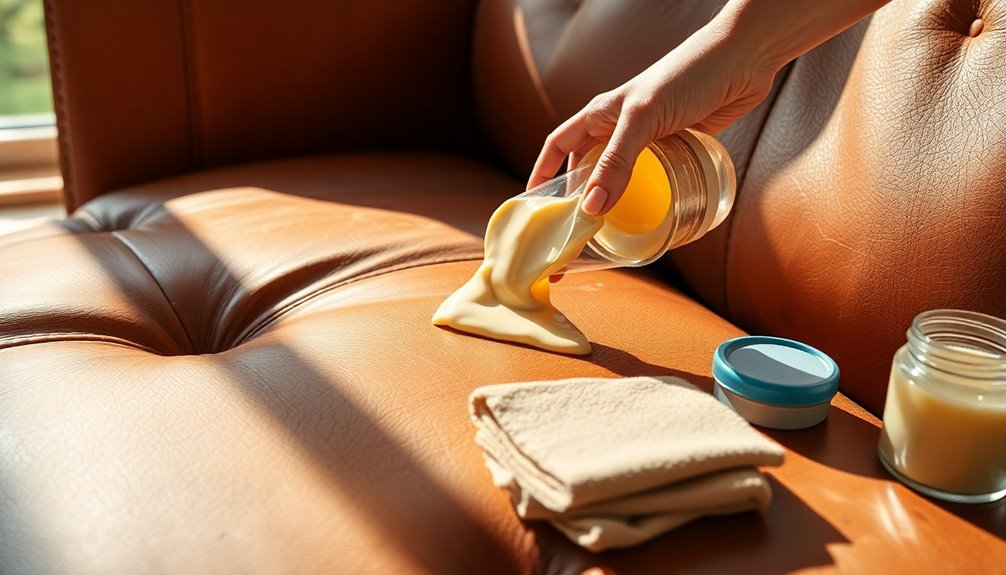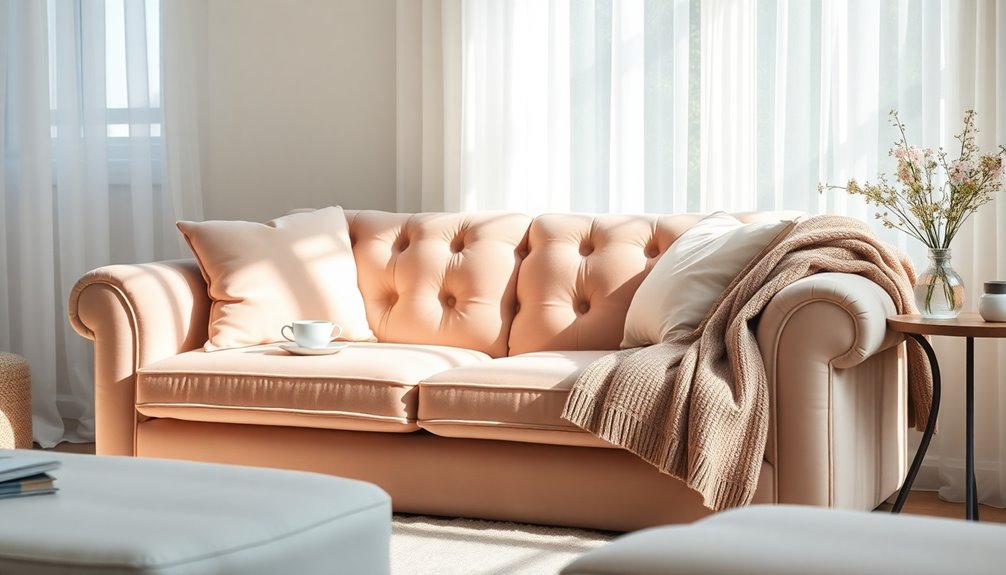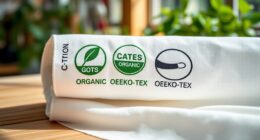To effectively get rid of stains on your sofa, it is important to act quickly. Begin by blotting wet stains with a dry towel or scraping off residue from dry stains. Always refer to the fabric care tag for specific instructions. For typical stains, create a mixture of dish soap and cool water, then gently blot the affected area. Stubborn marks may require a solution of vinegar and water, or you can sprinkle baking soda to absorb grease. If the stain persists, professional cleaning may be necessary. Regularly cleaning and protecting your upholstery from spills is essential for maintenance. Stay tuned for more tips on successful stain removal and prevention techniques. Avoid using harsh chemicals that could harm the fabric, and always conduct a patch test on a hidden area prior to using any cleaning solution. For effective stain removal from sofa cushions or armrests, consider using a steam cleaner for a deep clean, especially for delicate fabrics. By keeping up with routine maintenance, you can significantly prolong the lifespan of your sofa and maintain its fresh appearance.
Key Takeaways
- Blot wet stains immediately with a dry towel to absorb excess liquid and prevent spreading.
- For dry stains, scrape off residue gently and vacuum the area before cleaning.
- Test cleaning solutions on a hidden fabric area to avoid discoloration or damage.
- Use appropriate methods like dish soap and water, or baking soda for specific stains.
- Consider professional cleaning for delicate fabrics or stubborn stains that DIY methods can't remove.
Importance of Quick Stain Removal
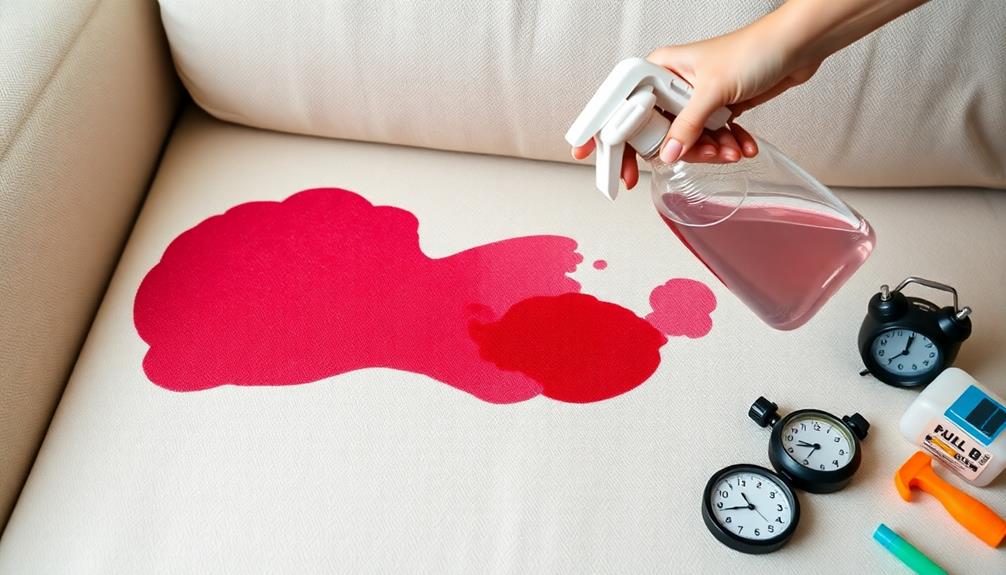
Acting quickly when a stain occurs is essential for effective removal. When you take quick action, you increase the likelihood of completely eliminating the stain before it penetrates deeper into the fibers of your sofa.
Immediate attention to spills and accidents not only simplifies the cleaning process but also prevents complications that arise from delayed treatment, such as the potential for ear pressure during colds if moisture is left in the fabric.
If you wait too long, you may find it increasingly difficult to remove stains, leading to irreversible damage and a decline in your sofa's appearance.
DIY methods can work wonders when applied promptly, but if the stain has set in, you might need professional help to achieve the best results.
Preparation for Stain Removal
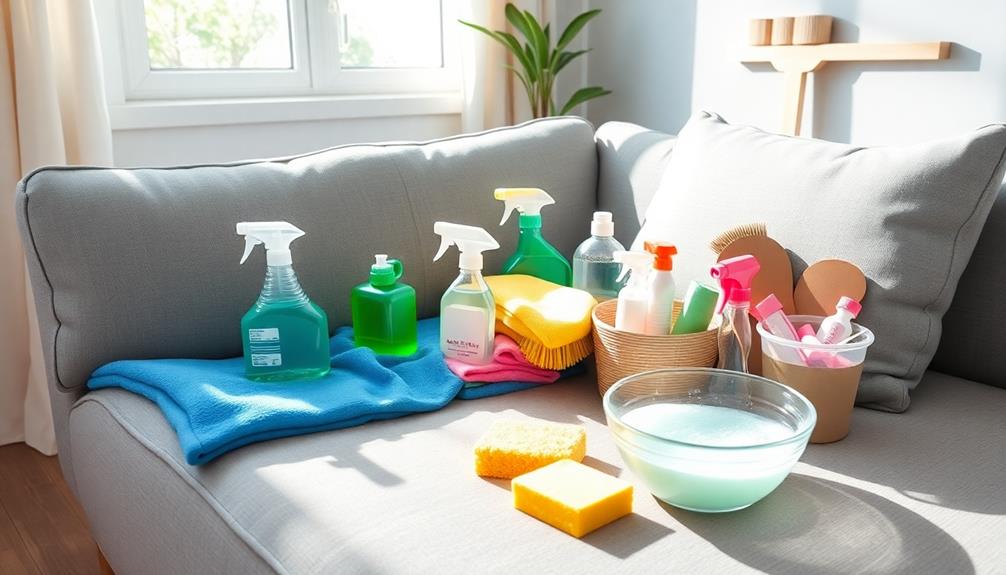
How can you guarantee your sofa is ready for effective stain removal? Start by addressing any wet stains immediately. Blot the area with a dry, absorbent towel to soak up excess liquid.
For dry stains, gently scrape off any residue and vacuum the area to minimize mess. Additionally, using a best vacuum for dust removal can help eliminate any dust or debris before you begin cleaning.
Next, always check the fabric care tag for specific cleaning instructions. This tag provides essential information through cleaning codes like W, S, S/W, WASH, and X, which guide you on the appropriate cleaning methods.
Once you know your fabric's requirements, prepare your cleaning supplies based on the fabric type and stain nature. Spot-cleaning is usually recommended for most stains, and if your upholstery covers are removable, consider washing them on a gentle cycle for easier maintenance.
Before applying any cleaning solution, test it on a hidden area of the fabric to ascertain it won't cause damage or discoloration. By taking these steps, you'll set the stage for successful stain removal and protect your sofa from potential harm.
Common Cleaning Methods
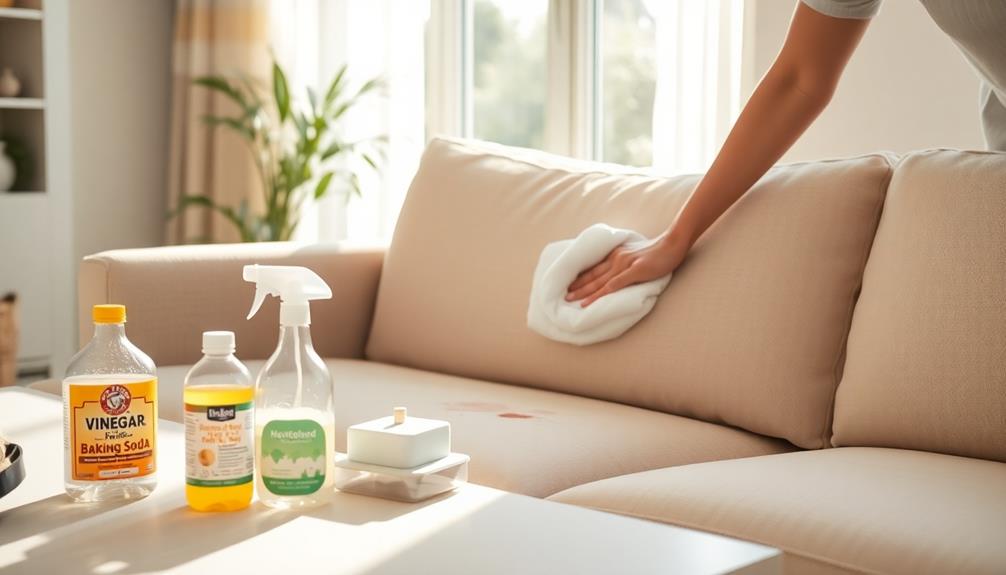
Effective stain removal relies on choosing the right cleaning method for your sofa's fabric and the type of stain you're dealing with.
One popular approach is the dish soap and water method, which is similar to the best practices for organizing prep tables to avoid contamination. Simply mix clear dish soap with cool water, then blot the stain gently to avoid damage.
If you're facing greasy stains, sprinkle baking soda on the area to absorb excess oil. Let it sit for about 20 minutes before vacuuming it off.
For various stains, try a vinegar and dish soap solution by combining three parts warm water with one part vinegar. Dab this mixture onto the stain, then rinse and absorb moisture.
If you're dealing with wax stains, use the ice and cold water technique: harden the wax with ice, scrape off the excess, and follow up with suitable cleaning solutions.
Specific Stain Removal Techniques
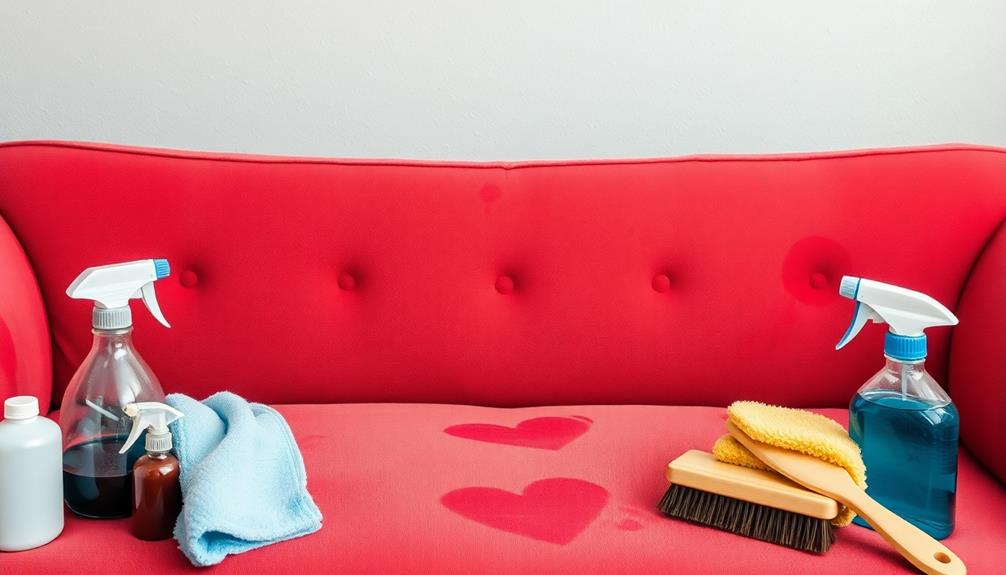
When you spill red wine on your sofa, act fast by blotting it with a clean cloth and using carbonated water to help lift the stain.
Essential oils such as eucalyptus oil can also be effective in cleaning and maintaining the freshness of your upholstery.
For grease or oil marks, sprinkle cornstarch or baking soda, let it sit, and then gently scrub with dish soap.
These targeted techniques can greatly improve your chances of restoring your sofa to its original condition.
Red Wine Remediation
If you find yourself dealing with a red wine stain on your sofa, acting quickly is essential for the best chance of removal.
Start by grabbing a clean, dry cloth and gently blot the area to absorb as much wine as possible—avoid rubbing, as this can push the stain deeper into the upholstery.
To maintain a clean living environment, it's also important to contemplate using an air purifier maintenance guide to reduce allergens and dust that can settle on your furniture.
Follow these steps for effective stain removal:
- Pour carbonated water directly onto the stain and blot it dry; the carbonation works wonders in lifting the wine.
- Mix ¼ cup of baking soda with ⅓ cup of water to create a paste. Apply it to the stain and let it dry before vacuuming it off.
- For stubborn stains, combine one part vinegar with three parts water. Blot the area with this mixture, then rinse with cold water.
Grease Stain Solutions
Red wine stains can be a challenge, but grease stains pose their own set of difficulties. To tackle a grease stain effectively, start by sprinkling cornstarch or baking soda directly on the stain.
Let it sit for 15-20 minutes to absorb the grease, then vacuum it up. Next, mix a cleaning solution of dish soap and warm water. Applying this mixture with a soft brush, gently scrubbing the affected area can be effective, especially when using a high-performance cleaning solution that targets tough stains energy-saving features can also be beneficial.
After scrubbing, use a clean cloth to blot the stain, removing excess moisture. If the stain proves stubborn, consider using commercial stain removers designed specifically for grease removal. Always follow the manufacturer's instructions carefully for the best results.
Additionally, if your sofa fabric is water-safe, steam treatment can help lift the grease, making it more responsive to your cleaning solutions. Before applying any cleaning solution, it's essential to test it on a hidden area of the fabric to verify it won't cause discoloration or damage.
With these techniques, you'll be well on your way to restoring your sofa to its original condition.
Professional Cleaning Options
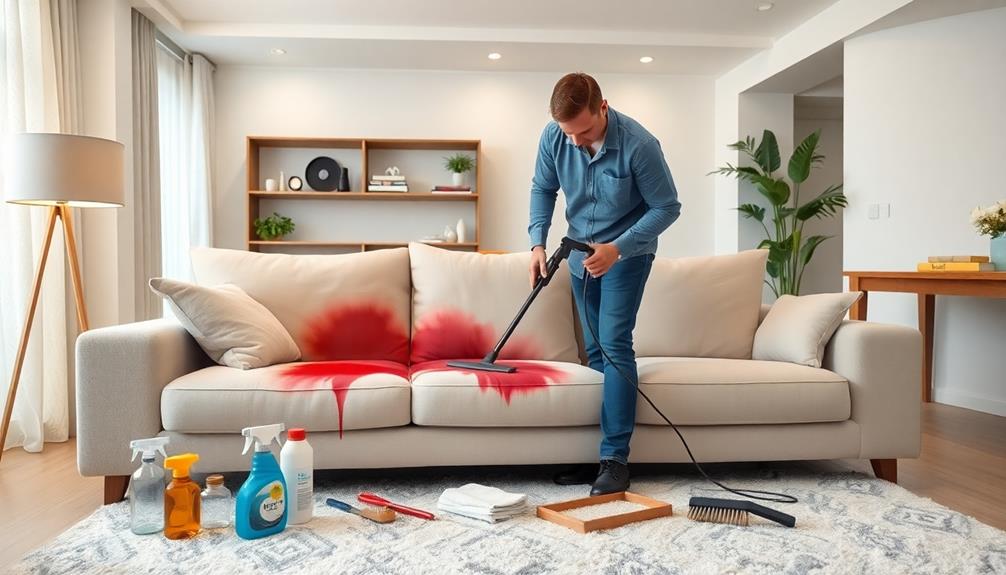
Professional cleaning options can be a game-changer for your sofa, especially when dealing with tough stains. If you've tried various DIY methods without success, it might be time to call in a professional upholstery cleaner.
They utilize advanced techniques like steam cleaning and specialized stain removers, which can effectively tackle stubborn stains that set in over time. Additionally, many professional cleaners emphasize the importance of regular maintenance to prolong the life of your upholstery, similar to the way preventive maintenance extends appliance lifespan.
When considering professional services, keep these points in mind:
- Cost: Expect to pay between $100 to $300 for standard fabric sofas, while high-end materials like suede may reach up to $500.
- Personalized Approach: Many local cleaners offer custom contracts tailored to your specific cleaning needs, guaranteeing a more personalized experience.
- Assessment: Professionals conduct a thorough assessment of your fabric type and existing stains. This guarantees they recommend the most effective cleaning process.
For delicate or high-value fabrics, it's vital to seek professional help to avoid damage or discoloration.
Preventative Measures for Stains

To keep your sofa looking great, regular upholstery cleaning is essential.
Incorporating effective preparation into your cleaning routine can help you identify and address potential stains before they set in.
You should also consider applying protective fabric treatments to create a barrier against spills.
These simple steps can save you from future headaches when it comes to stains.
Regular Upholstery Cleaning
Maintaining your sofa through regular upholstery cleaning is essential for preventing stains and extending its lifespan. By implementing a consistent cleaning routine, you can keep your furniture looking fresh and inviting.
Here are a few tips to help you effectively prevent stains:
- Vacuum regularly: Regular vacuuming prevents dust and crumbs from embedding in the fabric, reducing the chance of stains setting in. Additionally, being mindful of your budget can help you allocate resources for cleaning supplies and services when necessary, ensuring your upholstery remains in top condition for the long term. creating a personal budget
- Use upholstery protection sprays: These cleaning products create a barrier against stains, making spills easier to clean and minimizing long-term damage.
- Educate household members: Teach everyone in your home to avoid spills and maintain a cleaning kit for quick access to solutions.
Additionally, implementing a deep cleaning schedule, which includes brushing upholstery and treating odors, will enhance the longevity and appearance of your sofa.
If you have slipcovers, consider using them for added protection; they're easy to wash and maintain.
Protective Fabric Treatments
Applying protective fabric treatments is one of the most effective ways to prevent stains on your sofa. Upholstery protection sprays create a barrier that helps keep spills from penetrating the fabric, making cleanup easier. To maintain the effectiveness of these protective treatments, regular cleaning is essential. This not only keeps your sofa looking fresh but also helps preserve the protective layer.
Educating your household members about avoiding spills can further reduce the likelihood of accidents. Additionally, having a well-stocked cleaning kit on hand guarantees that any spills can be addressed immediately, minimizing potential staining. Using slipcovers or throws can also provide an extra layer of protection, allowing for easy cleaning or replacement.
Here's a quick reference table for protective measures:
| Protective Measure | Benefits |
|---|---|
| Upholstery Protection Spray | Creates a barrier against stains |
| Regular Cleaning | Maintains protective treatments |
| Educating Family | Reduces risk of spills |
| Cleaning Kit | Enables immediate action on spills |
| Slipcovers/Throws | Adds extra protection and easy maintenance |
Frequently Asked Questions
How to Get Stains Out of a Fabric Sofa?
To get stains out, you'll want to blot spills immediately with a cloth. Check the fabric care tag, then use a suitable cleaning mixture or baking soda for tough stains, applying and blotting carefully.
Can Old Stains Be Removed From Sofa?
Imagine a stubborn weed in your garden; just like you wouldn't give up on it, don't give up on old stains. With persistence, the right cleaning methods, and patience, you can restore your sofa's beauty. Just as understanding your garden’s needs helps you tackle weeds more effectively, learning the right techniques can make a world of difference with those tough stains. From choosing the correct cleaning agents to applying gentle scrubbing techniques, persistence pays off. And if you’re ever facing a situation where a stain seems permanent and you’re contemplating how to remove an old sofa altogether, remember that restoration is often possible with the right approach.
Does Baking Soda Remove Couch Stains?
Yes, baking soda can effectively remove couch stains. Just sprinkle it on the affected area, let it sit, then vacuum. For stubborn stains, mix it with water to create a paste for deeper cleaning.
How Do You Get Dried Stains Out of Upholstery?
To get dried stains out of upholstery, start by vacuuming the area. Then, apply a mixture of dish soap, vinegar, and warm water. Let it sit, blot with a damp cloth, and repeat if necessary.
Conclusion
In summary, tackling stains on your sofa promptly can save you time and money. Did you know that 80% of stains can be effectively removed if treated within the first 48 hours? By following the right cleaning methods and preventative measures, you can keep your sofa looking fresh and inviting. Remember, a little effort now can prevent a bigger headache later, so stay proactive and enjoy your beautiful furniture for years to come!

